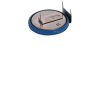This involves charging a button cell battery with red LEDs...
I've got a few of these batteries:
Sanyo ML2430 prepped with pc pins. 24mm diameter x 3mm thick rechargeable manganese dioxide lithium coin cell. 3Vdc, 90 mAh capacity. Charge at 3.1Vdc, 0.5mA. 3-pin, pc mount.
Not a huge capacity, but a flashing LED should last most of a night off one day of charging. Using a solar panel seemed like a huge waste, since the charging current is so small, so I tried some red LEDs in series and a blocking diode. First, I tried some fairly bright, water clear. Two in series should give 3 volts, but wasn't sure about current, figured really low, so I doubled them up in parallel. Works, but needs to be aimed directly at the sun. So, I took it in, put 6 LEDs in series, figured it would make up for not being aligned directly toward the sun, only got 2.2 volts. Pointing it at the sun, I got 9.1 volts (oops).
Finally settled on 4 wide angle red LEDs in series. Get at least 3 volts, regardless of where its pointing. Now I need to figure out a simple low power light/dark switch. Any ideas or or direction I should look into. I'm a little stuck on mis-using LEDs, but doubr that's the way to go. An LDR circuit would probably be a current hog, and a little more than is needed to switch in a flashing red LED.
I've got a few of these batteries:
Sanyo ML2430 prepped with pc pins. 24mm diameter x 3mm thick rechargeable manganese dioxide lithium coin cell. 3Vdc, 90 mAh capacity. Charge at 3.1Vdc, 0.5mA. 3-pin, pc mount.
Not a huge capacity, but a flashing LED should last most of a night off one day of charging. Using a solar panel seemed like a huge waste, since the charging current is so small, so I tried some red LEDs in series and a blocking diode. First, I tried some fairly bright, water clear. Two in series should give 3 volts, but wasn't sure about current, figured really low, so I doubled them up in parallel. Works, but needs to be aimed directly at the sun. So, I took it in, put 6 LEDs in series, figured it would make up for not being aligned directly toward the sun, only got 2.2 volts. Pointing it at the sun, I got 9.1 volts (oops).
Finally settled on 4 wide angle red LEDs in series. Get at least 3 volts, regardless of where its pointing. Now I need to figure out a simple low power light/dark switch. Any ideas or or direction I should look into. I'm a little stuck on mis-using LEDs, but doubr that's the way to go. An LDR circuit would probably be a current hog, and a little more than is needed to switch in a flashing red LED.


